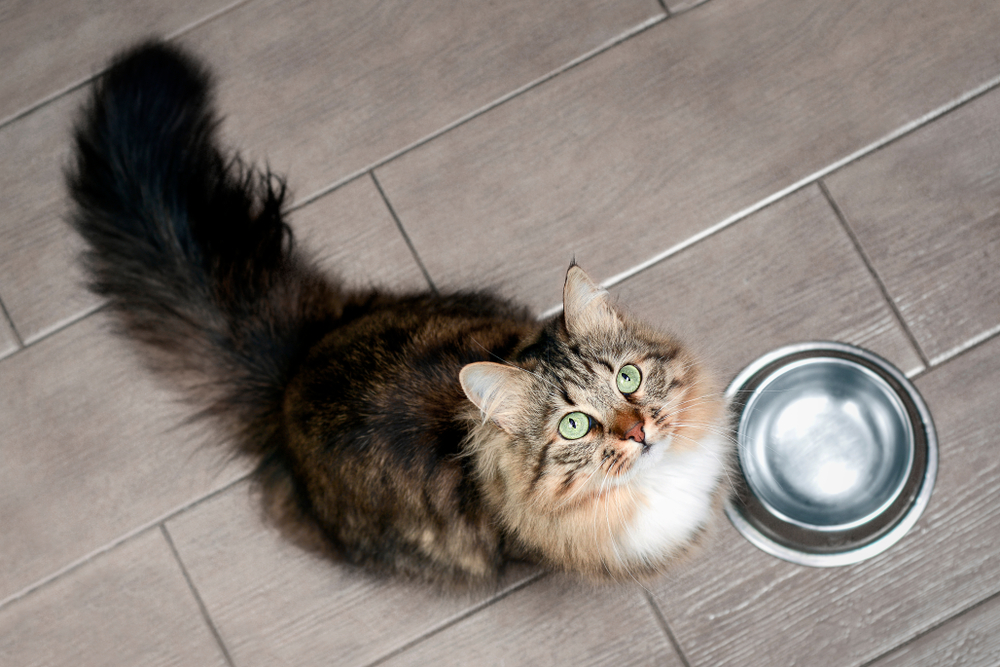Changes in your pet’s eating and drinking habits may indicate a serious health issue, which means recognizing these signs as soon as possible is important so the condition can be addressed. Our Animal Care & Emergency Services team explains issues that can affect your pet’s eating and drinking habits and encourages you to seek veterinary care if their appetite or thirst has changed.
#1: Chronic kidney disease can affect your pet’s appetite and thirst
Properly functioning kidneys are critical to your pet’s health. Chronic kidney disease (CKD) is prevalent in pets, especially senior cats, affecting 81% of felines over 15 years of age. Pets typically don’t show kidney disease signs until the later stages when more than 70% of kidney function is compromised. As the kidneys lose their ability to filter out waste material, the toxins accumulate in the bloodstream, causing the affected pet to feel ill. In fact, many lose interest in food. In addition, the kidneys no longer can produce concentrated urine, which causes increased urination to help clear the accumulated toxins. This leads to a compensatory increase in thirst and water consumption.
#2: Dental disease can affect your pet’s appetite and thirst
Periodontal disease is the most common condition affecting pets. The majority of pets experience some degree of periodontal disease by the time they are 3 years of age, and the condition can lead to serious health complications. Bacteria invade under the gumline, leading to swollen, painful gums, loose and missing teeth, and tooth-root abscesses. These issues can cause significant mouth pain, making eating and drinking difficult for your pet. The best way to address and prevent periodontal disease is to schedule regular veterinary dental cleanings and brush your pet’s teeth daily.
#3: Diabetes can affect your pet’s appetite and thirst
Diabetes affects approximately 1 in 300 dogs and 1 in 230 cats during their lifetime, and reports indicate the disease prevalence is trending upward. If left untreated, this condition can cause ketoacidosis, cataracts (in dogs), kidney disease, chronic pancreatitis, and nerve degeneration. Diabetic pets can’t use glucose for energy, making hunger satiation difficult, and they often have an increased appetite despite weight loss. Diabetic pets also tend to drink more water because the excess glucose in their blood pulls water out, resulting in increased urination and a compensatory rise in thirst.
#4: Arthritis can affect your pet’s appetite and thirst
Arthritis is common in pets, especially senior pets, but many pet owners dismiss changes in their furry companion’s mobility as normal age-related factors. While some arthritic pets have a limp, many exhibit more subtle signs, such as difficulty navigating stairs, stiffness after resting, reluctance or refusal to jump on or off elevated surfaces, difficulty getting up from a resting position, and decreased interest in play. In addition, the significant pain caused by arthritic joints can affect your pet’s appetite and water intake. Pets who are in pain often are not interested in food and may not drink as much water as usual. If your senior pet is slowing down, schedule a veterinary appointment to determine if arthritis is a factor. Numerous medications and therapies are available to help alleviate an arthritic pet’s pain and discomfort and improve their quality of life.
#5: Hyperthyroidism can affect your pet’s appetite and thirst
Hyperthyroidism is caused by an increase in thyroid hormone production as a result of an enlarged thyroid gland and most often affects middle-aged and older cats. The exact cause is unknown, but possible contributing factors include chronic exposure to thyroid-disrupting chemicals in a cat’s food or environment and diet deficiencies or excesses. Hyperthyroidism raises a cat’s metabolism, which increases their appetite and thirst. Other signs include weight loss, hyperactivity, unkempt hair coat, and, in some cases, vomiting and diarrhea.
#6: Cushing’s disease can affect your pet’s appetite and thirst
Cushing’s disease, or hyperadrenocorticism, occurs most commonly in middle-aged and senior dogs. The condition usually is caused by a benign pituitary tumor that overproduces a hormone that, in turn, stimulates the adrenal glands to produce cortisol. Excessive cortisol levels can lead to high blood pressure, bladder stones, diabetes, chronic skin and urinary tract infections, and an increased risk of blood clots. High cortisol levels also stimulate a pet’s appetite and thirst, leading to increased hunger and water intake. Other signs include hair loss, oily skin, pot-belly appearance, lethargy, and weight gain.
#7: Gastrointestinal issues can affect your pet’s appetite and thirst
Pets can experience gastrointestinal (GI) issues, such as vomiting, diarrhea, and nausea, for many reasons, including dietary indiscretions, viral and bacterial infections, parasites, and food allergies. GI upset can cause a significant decrease in your pet’s appetite and thirst.
#8: Stress can affect your pet’s appetite and thirst

Some pets, especially cats, are sensitive to small changes in their environment, leading to stress and anxiety. Such things as moving your furniture, construction in or around your home, introducing a new pet to your family, returning to a school-year schedule, and a dirty litter box may trigger stress in your pet. One way your pet may express anxiety is to avoid their food or water bowl. Other potential signs include hiding, irritability, destructive behavior, and urinating outside the litter box. Identifying and removing the stressor is critical to relieve your pet’s anxiety.
If your pet’s eating or drinking habits change and indicate an issue that requires specialty care, contact our Animal Care & Emergency Services team so we can evaluate their condition and devise an appropriate treatment plan.







Leave A Comment